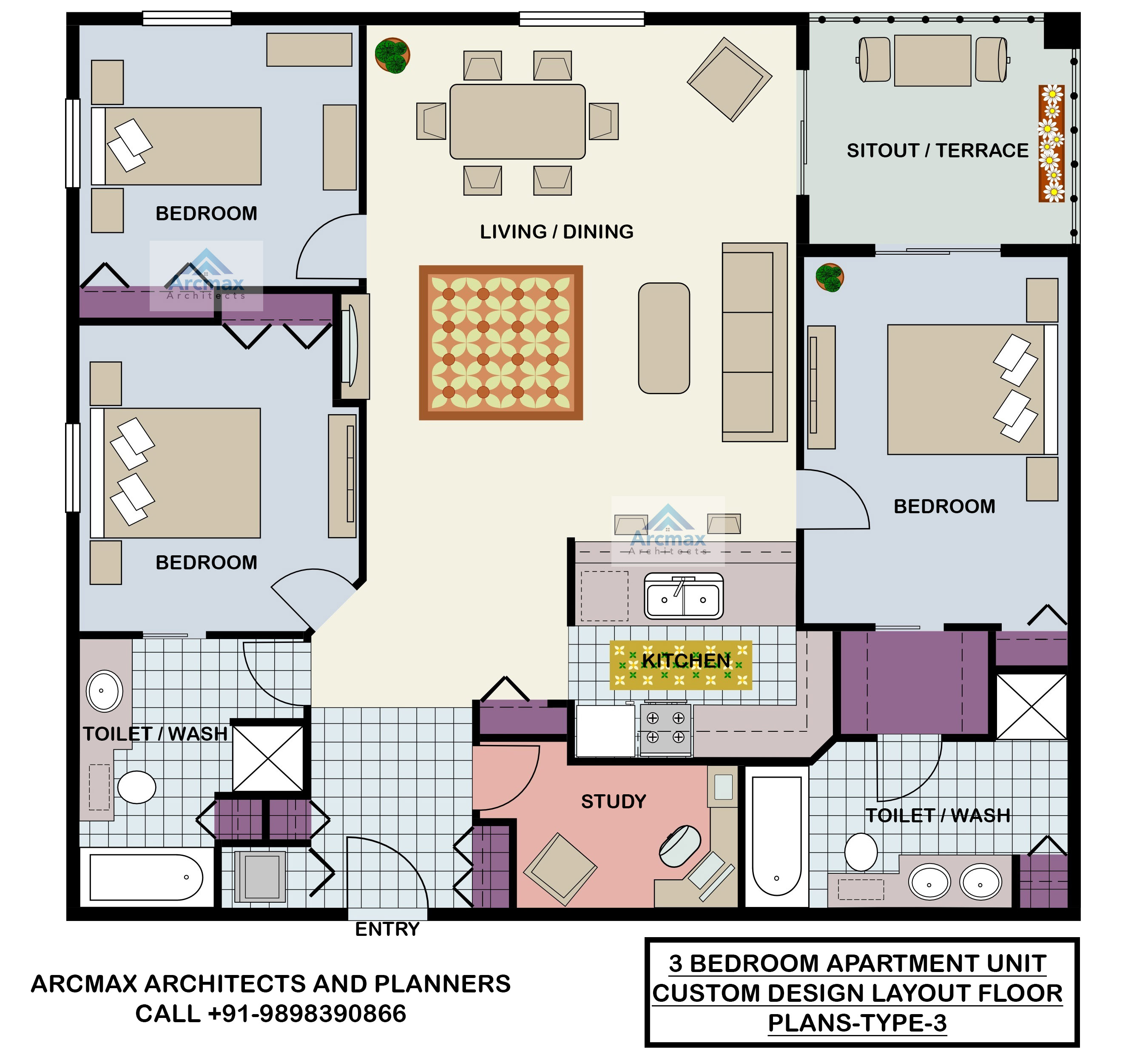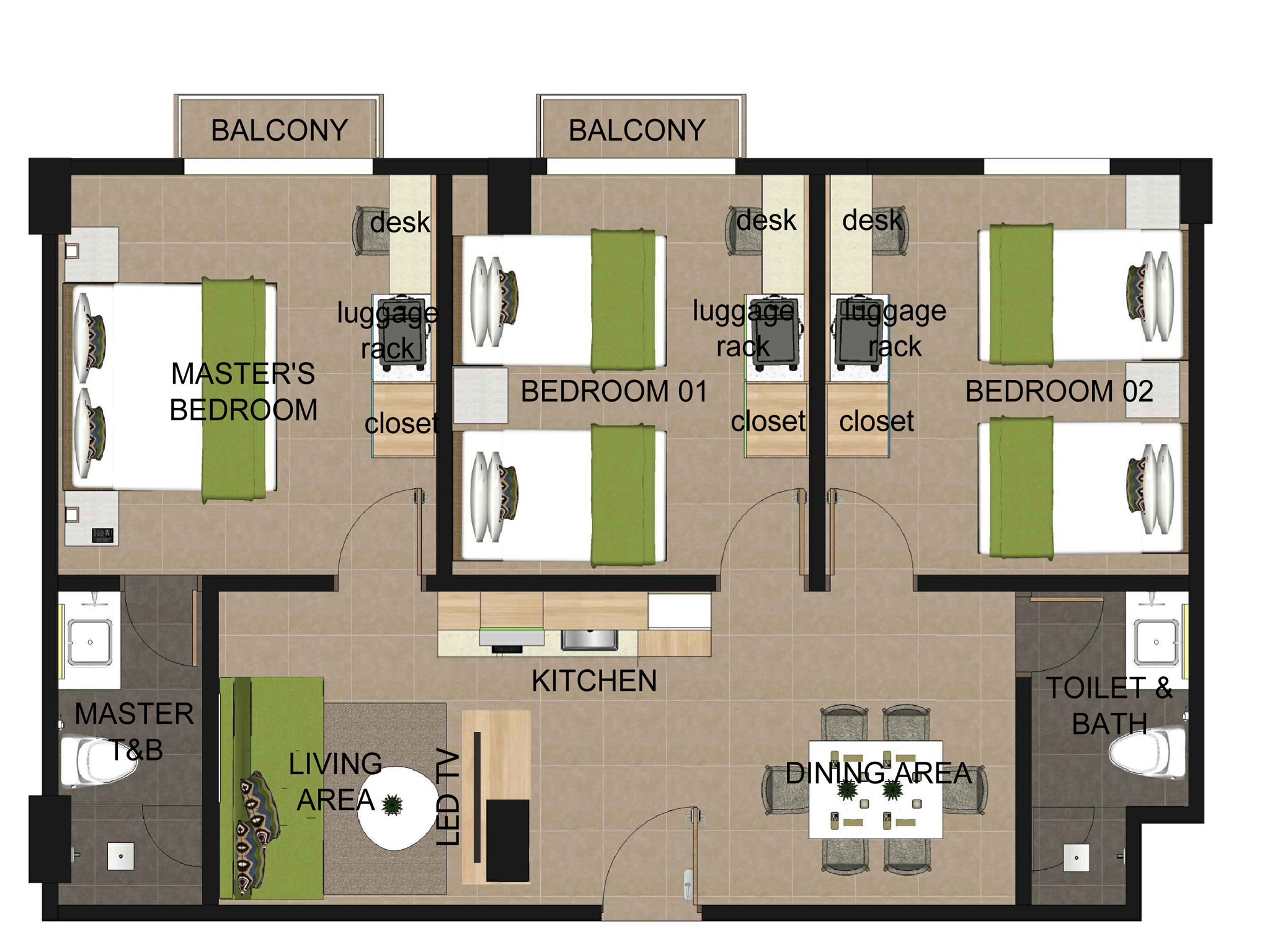Planning and Design Considerations

Architectural designs for 3 bedroom flat – Creating a well-designed 3-bedroom flat requires careful planning and consideration of various factors. The success of the design hinges on understanding the site, the intended occupants, and relevant regulations.
Architectural designs for a 3-bedroom flat can range from minimalist and modern to spacious and traditional, offering a variety of layouts to suit different needs and preferences. If you’re on a budget, exploring options for cheap 3 bedroom homes might be a good starting point.
This could involve exploring pre-designed plans or considering cost-effective building materials and construction techniques. Regardless of your budget, a well-designed 3-bedroom flat can provide a comfortable and functional living space for a family or individuals with a need for multiple rooms.
Site and Environment Analysis
Understanding the site and its surrounding environment is crucial for creating a functional and harmonious design. This involves analyzing factors such as:
- Site topography: The slope and orientation of the site influence the layout and natural light penetration.
- Existing infrastructure: Access to utilities, transportation, and nearby amenities impact the flat’s functionality and livability.
- Surrounding buildings: The height and density of neighboring structures affect the amount of natural light and ventilation the flat receives.
- Environmental factors: Climate, prevailing winds, and noise levels influence the design of windows, balconies, and outdoor spaces.
Layout and Flow Considerations, Architectural designs for 3 bedroom flat
The layout and flow of the flat directly impact its functionality and user experience. Key factors to consider include:
- Family size: The number of bedrooms, bathrooms, and living spaces should be tailored to the needs of the intended occupants.
- Lifestyle: The design should accommodate the occupants’ daily routines, hobbies, and entertainment preferences.
- Personal preferences: Incorporating individual preferences regarding space organization, furniture styles, and color schemes enhances the flat’s appeal.
- Accessibility: The design should consider the needs of individuals with disabilities, ensuring easy access and movement throughout the flat.
Building Regulations and Codes
Compliance with building regulations and local building codes is essential for a safe and legal design. Key considerations include:
- Fire safety: The design should meet fire safety requirements, including fire escape routes, fire-resistant materials, and smoke detectors.
- Structural integrity: The flat’s structure should meet building codes to ensure stability and safety.
- Energy efficiency: Regulations regarding energy efficiency, such as insulation standards and window glazing, should be adhered to.
- Accessibility requirements: Building codes often mandate accessibility features for people with disabilities, such as ramps and wider doorways.
Maximizing Natural Light and Ventilation
Maximizing natural light and ventilation is crucial for creating a comfortable and healthy living environment. Strategies include:
- Strategic window placement: Positioning windows to capture sunlight throughout the day and provide cross-ventilation.
- Use of skylights: Incorporating skylights to bring natural light into interior spaces, particularly in areas with limited window access.
- Lightwells and courtyards: Creating lightwells or courtyards to allow natural light to penetrate deeper into the flat.
- Ventilation systems: Installing mechanical ventilation systems to ensure adequate air circulation, especially in areas with limited natural ventilation.
Space-Saving Techniques
Maximizing the use of available space is essential in a 3-bedroom flat. Effective space-saving techniques include:
- Multifunctional furniture: Using furniture that serves multiple purposes, such as a sofa bed or a dining table that converts into a desk.
- Built-in storage: Incorporating built-in storage solutions, such as cabinets, shelves, and drawers, to maximize vertical space.
- Open floor plans: Creating open floor plans to make the space feel larger and more connected.
- Mirrors: Using mirrors to create the illusion of more space and reflect light.
Functional Design and Space Allocation

The functional design and space allocation of a 3-bedroom flat play a crucial role in creating a comfortable and efficient living environment. It involves strategically planning the layout to optimize the use of space, ensuring a clear separation between public and private areas, and accommodating the specific needs of each room.
Floor Plan Layout
A well-designed floor plan for a 3-bedroom flat prioritizes a clear distinction between public and private areas. This separation enhances privacy and allows for distinct activities to occur simultaneously. The public area, typically encompassing the living room, dining area, and kitchen, is designed for social interaction and communal activities. Conversely, the private area houses the bedrooms and bathrooms, providing personal space and refuge.
A well-designed floor plan for a 3-bedroom flat prioritizes a clear distinction between public and private areas. This separation enhances privacy and allows for distinct activities to occur simultaneously.
Bedroom Design
Each bedroom in a 3-bedroom flat requires careful consideration to meet the individual needs of its occupants. The layout should incorporate ample storage space to minimize clutter and maximize the sense of order. A well-designed wardrobe or built-in storage solutions can effectively address this requirement. Furthermore, providing dedicated workspaces within bedrooms can be beneficial for individuals who work from home or require a designated area for study.
Each bedroom in a 3-bedroom flat requires careful consideration to meet the individual needs of its occupants. The layout should incorporate ample storage space to minimize clutter and maximize the sense of order.
Kitchen Design
The kitchen is the heart of a home, serving as a hub for cooking, dining, and socializing. A functional kitchen design prioritizes efficient work areas, adequate storage space, and a comfortable layout. The kitchen triangle, a concept that positions the sink, stove, and refrigerator in a triangular arrangement, is a fundamental principle of kitchen design. This configuration optimizes workflow and minimizes unnecessary movement. Ample storage solutions, such as cabinets, drawers, and pantries, are essential for organizing kitchenware, appliances, and food items.
A functional kitchen design prioritizes efficient work areas, adequate storage space, and a comfortable layout. The kitchen triangle, a concept that positions the sink, stove, and refrigerator in a triangular arrangement, is a fundamental principle of kitchen design.
Living Room Design
The living room is a space for relaxation, entertainment, and social gatherings. Its design should prioritize comfort and create a welcoming ambiance. Seating arrangements should be conducive to conversation and relaxation, with options for individual seating and group gatherings. Incorporating entertainment features, such as a television, sound system, or fireplace, enhances the functionality and enjoyment of the living room.
The living room is a space for relaxation, entertainment, and social gatherings. Its design should prioritize comfort and create a welcoming ambiance.
Bathroom Design
A well-planned bathroom prioritizes comfort and functionality. Adequate space for bathing, showering, and getting ready is crucial. Incorporating features such as a separate shower stall, a double vanity, and ample storage space enhances the overall experience.
A well-planned bathroom prioritizes comfort and functionality. Adequate space for bathing, showering, and getting ready is crucial.
Architectural Styles and Aesthetics: Architectural Designs For 3 Bedroom Flat

The architectural style of a 3-bedroom flat significantly influences its visual appeal and overall ambiance. Choosing the right style depends on personal preferences, budget, and the desired aesthetic.
Exploring Architectural Styles
Different architectural styles offer unique characteristics and visual appeal, each with its own set of design principles and elements. Here are some popular styles that can be applied to a 3-bedroom flat design:
- Contemporary: Emphasizes clean lines, minimalist aesthetics, and open floor plans. It often features large windows, neutral color palettes, and a focus on functionality. Examples include sleek furniture, geometric shapes, and the use of natural materials like wood and stone.
- Traditional: Revolves around classic architectural elements and decorative details. It typically incorporates ornate moldings, symmetrical layouts, and a sense of history. Common features include fireplaces, crown molding, and traditional furniture styles.
- Modern: Similar to contemporary but with a greater emphasis on functionality and efficiency. It often features bold geometric shapes, clean lines, and a focus on natural light. Examples include exposed brick walls, open floor plans, and the use of modern materials like steel and glass.
- Industrial: Characterized by exposed brick, metal accents, and a raw, unfinished aesthetic. It often features high ceilings, large windows, and a focus on functionality. Examples include reclaimed wood furniture, exposed pipes, and industrial lighting fixtures.
- Mediterranean: Inspired by the architecture of Mediterranean countries, it features arched doorways, terracotta tiles, and warm color palettes. It often incorporates elements of nature, such as stone walls, lush landscaping, and terracotta pots.
Comparing and Contrasting Design Aesthetics
Contemporary, traditional, and modern design aesthetics differ in their emphasis on functionality, ornamentation, and color palettes.
- Contemporary: Prioritizes functionality and simplicity, often featuring clean lines, open floor plans, and a minimalist approach to decoration. Color palettes are typically neutral, with a focus on natural light and a sense of spaciousness.
- Traditional: Emphasizes comfort, elegance, and a sense of history. It often features ornate moldings, decorative details, and a focus on symmetry. Color palettes are typically warm and inviting, with a preference for natural materials like wood and stone.
- Modern: Combines functionality with a focus on aesthetics, featuring clean lines, geometric shapes, and a minimalist approach to decoration. Color palettes are typically bold and contrasting, with a focus on natural light and a sense of spaciousness.
Color Palettes and Materials
The choice of color palettes and materials is crucial in creating the desired aesthetic for a 3-bedroom flat.
- Contemporary: Neutral color palettes, such as white, gray, and black, are often used to create a sense of spaciousness and tranquility. Natural materials like wood, stone, and leather are commonly incorporated to add warmth and texture.
- Traditional: Warm and inviting color palettes, such as beige, brown, and cream, are often used to create a sense of comfort and elegance. Traditional materials like wood, stone, and fabric are commonly incorporated to add texture and character.
- Modern: Bold and contrasting color palettes, such as black and white, or bright accents against neutral backgrounds, are often used to create a sense of energy and sophistication. Modern materials like steel, glass, and concrete are commonly incorporated to add a sleek and contemporary feel.
Sustainable Design Principles and Energy-Efficient Features
Incorporating sustainable design principles and energy-efficient features can enhance the environmental performance of a 3-bedroom flat.
- Energy-Efficient Windows: Double- or triple-paned windows can reduce heat loss in winter and heat gain in summer, leading to lower energy consumption for heating and cooling.
- High-Performance Insulation: Adequate insulation in walls, ceilings, and floors can minimize heat transfer, improving energy efficiency and reducing heating and cooling costs.
- Solar Panels: Installing solar panels on the roof can generate renewable energy, reducing reliance on fossil fuels and lowering electricity bills.
- Water-Saving Fixtures: Low-flow showerheads, faucets, and toilets can significantly reduce water consumption, conserving this precious resource.
- LED Lighting: LED lights consume less energy than traditional incandescent bulbs, reducing electricity consumption and contributing to sustainability.
Role of Furniture and Decorative Elements
Furniture and decorative elements play a vital role in enhancing the overall aesthetic of a 3-bedroom flat.
- Furniture: The choice of furniture should complement the architectural style and color palette of the flat. Contemporary styles often feature sleek and minimalist furniture, while traditional styles favor more ornate and comfortable pieces. Modern designs often incorporate a mix of functional and stylish furniture.
- Decorative Elements: Decorative elements, such as artwork, rugs, curtains, and throw pillows, can add personality and visual interest to the flat. These elements should be chosen to complement the overall aesthetic and create a cohesive look.
Architectural designs for a 3 bedroom flat can vary greatly depending on the desired aesthetic and functionality. If you’re looking for a more luxurious and spacious option, consider a 3 bedroom suite in Banff , which often features breathtaking mountain views and upscale amenities.
These designs can serve as inspiration for creating a sophisticated and comfortable living space within your own flat, incorporating elements like open floor plans, natural light, and well-defined zones for different activities.
